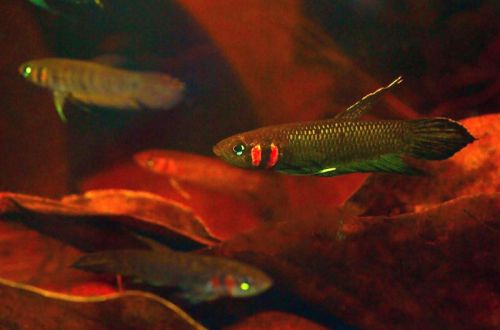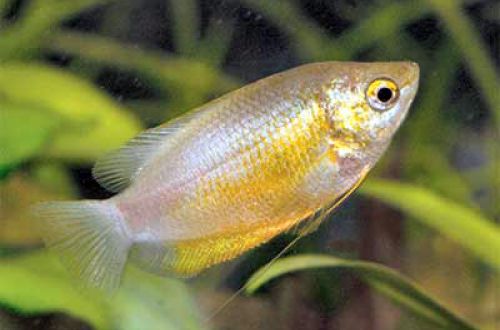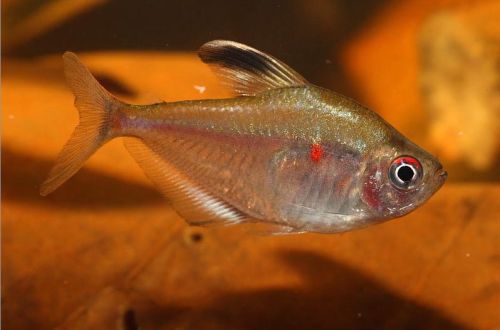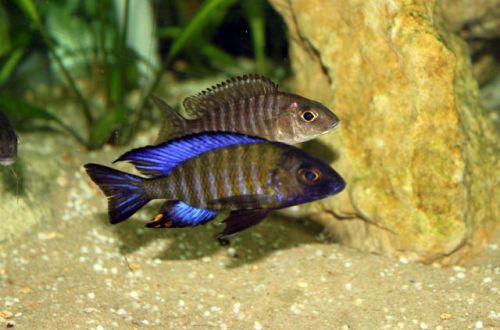
Betta Mandoru
Betta Mandor, scientific name Betta mandor, belongs to the Osphronemidae family. Prior to its scientific description in 2006, it was called the Ninja Rooster for its dark coloration and two bright stripes on its head, reminiscent of the cutouts for the eyes on the black clothing of these Asian mercenaries. The comparisons don’t end there. The fish is characterized by complex behavior – males tend to arrange skirmishes for territory and the attention of females, other species of similar coloring may even be attacked.

Contents
Habitat
It comes from Southeast Asia from the Indonesian part of the island of Borneo from the province of West Kalimantan. The specimens described were first collected in the Kapuas River basin between the two villages of Mandor and Anjungan. Inhabits shallow streams and rivers flowing through dense tropical forest. Sometimes the depth of the reservoir is only a few centimeters, due to the dense crowns of trees it is poorly lit, but this does not prevent the coastal and aquatic vegetation from actively growing. The bed is covered with a layer of fallen leaves, twigs, grass, during the decomposition of which humic acids and other substances are released that color the water brown.
Brief information:
- The volume of the aquarium – from 50 liters.
- Temperature – 22-27°C
- Value pH — 4.0–6.0
- Water hardness – 1–5 dGH
- Substrate type – any dark
- Lighting – subdued
- Brackish water – no
- Water movement – little or no
- The size of the fish is 4-5 cm.
- Food – any food
- Temperament – conditionally peaceful
- Content – males singly or in pairs male / female
Description
He is a close relative of Betta Fursh and has many similarities with him in body drawing. Adults reach a length of 5-6 cm. The fish has an elongated slender body. Males, unlike females, are somewhat larger, their unpaired fins are more expanded, the color is dark, and the characteristic lateral stripes behind the head are orange. Females look paler, the main colors are gray.
Food
An omnivorous species, it will accept most of the popular foods in the aquarium trade in dry, frozen and live form. The latter include brine shrimp, daphnia, bloodworms, you can also use fruit flies, mosquito larvae and other small insects. Many manufacturers produce special products designed for Betta fish that can become the basis of their diet.
Maintenance and care, arrangement of the aquarium
The optimal size of the aquarium for a pair of fish starts from 40 liters. The design is arbitrary and completely depends on the creative and financial capabilities of the aquarist. Betta Mandoru will look most harmonious in low light among snags and thickets of shade-loving plants against a dark substrate. The bottom may be covered with a layer of leaves of some trees. They are not only part of the decoration, but also serve as a source of tannins (humic acids) typical of their natural habitat. Read more in the article “Which tree leaves can be used in an aquarium.”
The main condition for successful maintenance is the maintenance of stable water conditions in the permissible range of temperatures and values of hydrochemical parameters. Fish prefer warm, slightly acidic and very soft water, which must be replaced weekly with fresh water. The uninterrupted operation of the installed equipment and the regular removal of accumulated organic waste (feed residues, excrement) are also responsible for the balance of biological balance.
It is important to remember that Petushka fish do not like strong and even moderate currents and need a warm, moist layer of air near the surface of the water. The first is solved by selecting the appropriate filter model (it is he who causes the movement of water), the second – by installing a cover on the tank.
Behavior and Compatibility
They belong to the group of fighting fish, which indicates the difficult disposition of this species. There are conflicting reports about the behavior of Betta Mandoru. Some sources say that males are extremely intolerant of rivals and other related species of similar color. Some females may also be persecuted by the alpha male. Other authors point out that while conflicts are not uncommon, they are more demonstrative and never result in injury. Given the above, we can conclude that in a small aquarium it is worth keeping only one male in the company of one or more females, as well as other types of non-aggressive fish unlike them. In large volumes, the restrictions are not so strict.
Breeding / breeding
In nature, the fish are in a not very favorable environment, subject to seasonal changes, when part of the forest streams dries up or turns into mud. Under these conditions, in the course of evolution, an unusual mechanism was developed to protect offspring in their most vulnerable period – the stage of eggs. Fertilized eggs are hatched in the mouth of the male, where they fall immediately after spawning. After 8–14 days, fully formed fry appear.
For breeding, only sexually mature male and female, a favorable environment and high-quality nutritious food are needed. The instincts will do the rest.
Fish diseases
The cause of most diseases is unsuitable conditions of detention. A stable habitat will be the key to successful keeping. In the event of symptoms of the disease, first of all, the quality of the water should be checked and, if deviations are found, measures should be taken to correct the situation. If symptoms persist or even worsen, medical treatment will be required. Read more about symptoms and treatments in the Aquarium Fish Diseases section.





